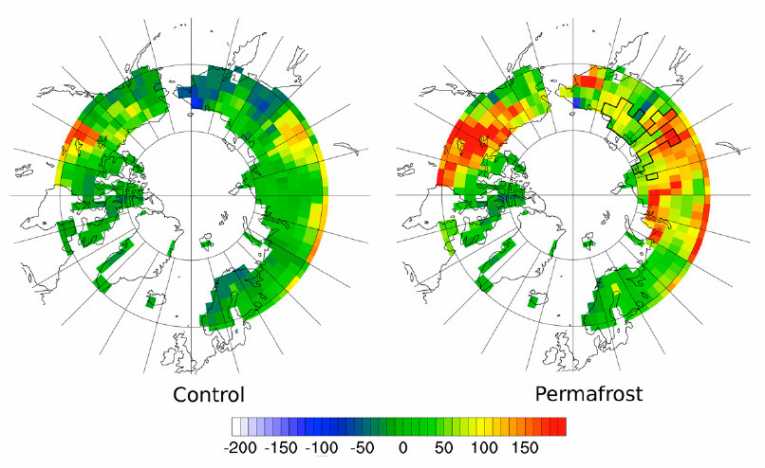Image Caption: A sink becomes a source, as revealed by these two simulations of net CO2 fluxes due to climate change at the end of 21st century. The control simulation on the left did not include permafrost processes. The permafrost simulation on the right included processes that depict how carbon accumulates in soil and how it decomposes. In the latter simulation, large carbon losses are seen in central Canada where substantial permafrost stocks exist that are vulnerable to warming. Units are in grams of carbon per square meter per year.
As high-latitude permafrost thaws following climate change, a new study reveals that released CO2 can accellerate the process.
North of latitude 60° much of the earth is permanently frozen in what is known as permafrost.
Models that were included in the Intergovernmental Panel on Climate Change in 2007 predicted that as the earth warmed up and the permafrost thawed, this would spark a growth in high-latitude vegetation.
Billions of tonnes of carbon are trapped in this permafrost and this will be released as the permafrost begins to thaw and early predictions were that the growth of the new vegetation would pull more carbon from the atmosphere than the permafrost would release.
New research led by Charles Koven of the US Department of Energy's Lawrence Berkley National Laboratory (Berkeley Lab) refutes these predictions. This new computer modelling study predicts that rather than absorbing carbon from the earth's atmosphere, by the end of the century the melting permafrost will release billions of tons of carbon that will further accelerate global warming.
The study that was published online in the Proceedings of the National Academy of Sciences (PNAS), also found that by the end of the 21stcentury, in response to climate change, as the soil in these high-latitude regions warms it could be transformed into a source of carbon dioxide rather than a sink.
What makes this study different is that it includes detailed processes of how carbon accumulates in high-latitude soil over millennia and how it is released as the permafrost thaws. Since it includes these processes, the model begins with much more carbon in the soil than previous models. It also better represents the carbon's vulnerability to decomposition as the soil warms.
Koven maintains that previous models tended to dramatically underestimate the amount of carbon in the soil in high latitudes. Since the present models starts off with more carbon in the soil, there is consequently more to lose with global warming.
Koven and his colleagues estimated that 2,167 petagrams of carbon are trapped in all layers of high-latitude soil. This is 2,167 x 1015grams or more than two trillion US tons.
In order to compare how carbon behaves at different levels, such as on the surface or 30 centimetres below, the scientists modified a land surface ecosystem model called ORCHIDEE. They also considered the rate of decomposition of soil carbon as a function of the temperature at the freeze-thaw boundary, which sinks deeper and deeper as the soil's temperature rises.
Other fresh improvements included soil physics that more realistically captured the effects of organic matter on carbon.
Their simulations revealed that the best estimate of a climate-induced loss that included all the permafrost processes was that by 2100 62 petagrams of soil carbon would be released into the atmosphere. That is equivalent to about 68 billion US tons or 61.7 billion tonnes. This release of carbon is equivalent to an additional 7.5 years of global anthropogenic emissions at today's rate.
Koven points out that there are still large uncertainties in the model that need to be addressed. More research is needed to better understand the processes that cause the permafrost to release its carbon.
Top Image Credit: © U.S. Department of Energy's Lawrence Berkeley National Laboratory










